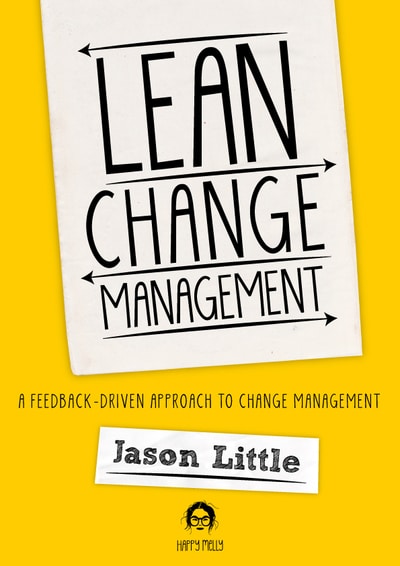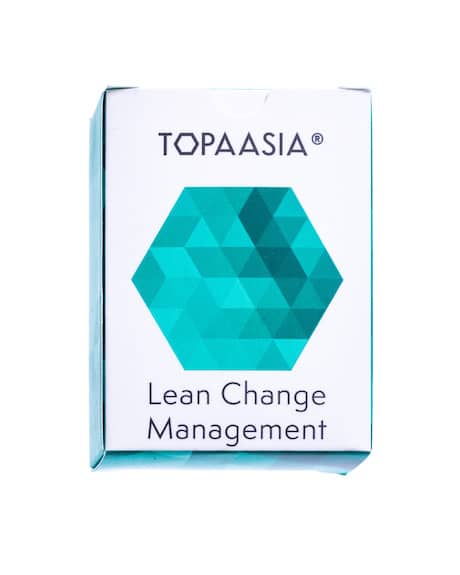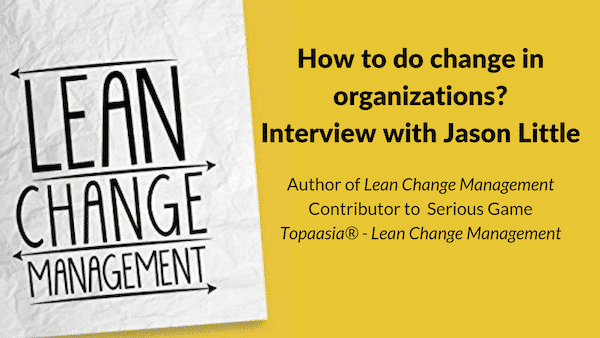
Jason Little is an Canadian author and developer of Lean Change Management – Innovative Practices for Managing Organizational Change. He’s also international speaker and creator of crazy ideas at Leanintuit.
What Lean Change Management means?
People ask me: “Why you put the “lean” in front of “change management”? What I mean by lean is the definition of the term: As thin and light as possible. So Lean Change Management means to keep your processes as simple as you possibly can. That way you can focus on the real change that matters and you can toss out all the heavyweight governance, documents and frameworks. In short it means finding the ideas that work in your context and throwing the other ones out.
How should people associated with change (leaders, management, coaches) think about lean change management? Is it a process, framework, philosophy or something else?
Most people call it a framework, because it has to have some kind of label on it. Some people call it a method, some people call it a tool or a model. Most people call it a framework because it gives a bunch of tools to operate with.
Change Management and Lean are often associated with IT-industry. Is the idea of Lean Change Management only for IT or for other industries as well?
Any industry. It’s for people who want to modernize how they approach change. Normally the way we do it is to lock change people in a room where they come up with the perfect plan based on the methods that they’re using. Then they try to unleash it and they blame people for resisting. That doesn’t work. LCM takes ideas from Lean Startup, design thinking, agile, and lean, in order to help change agents pick the right tool for the job.
People generally have an idea about why this change is important. They might not be able to verbalize it, but they all kind of “get it” to a certain degree. In fact, I recently ran an internal workshop where the 30 or so managers and leaders said “we don’t have a vision from the top so we can’t do anything”. After working through an organizational change canvas, they realized they didn’t really need a fully formed vision, they all understood the reason why the organization wanted to change. We try to over-define most change ie. “We need a proper vision statement. We need a proper strategy,etc...”. It’s usually very binary in nature and we burn so much energy dealing with that stuff. We all kind of know that today’s business world is different. We all know we have to do things faster, better and cheaper.
The main idea with lean change management is to always focus on the most important things we need to do in order to take one little step forward.
We don’t have to wait for a fully formed vision statement to take action. We just couldn’t wait around even if we wanted to, the markets change too fast around us. Sometimes it’s better to think of a change as; “what three things can we do this month to make it better”.
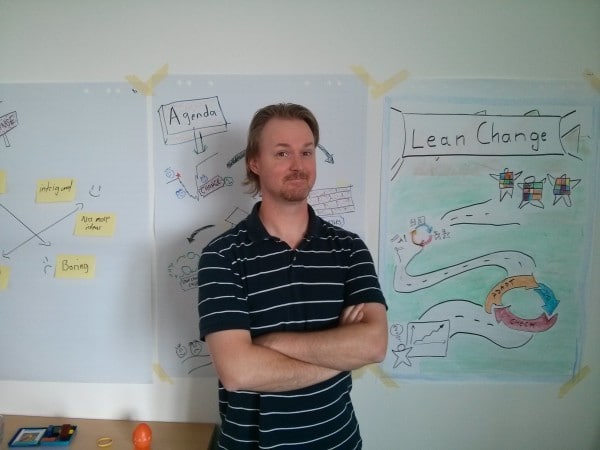
Jason Little, source: leanchange.org
Uncertainty reduction theory
If you like the models that are underneath LCM there is a theory called Uncertainty reduction theory. People don’t like uncertainty generally speaking. We want to predict the future as much as we can. Of course the paradox is that we want to predict the future but we can’t. Uncertainty reduction theory is a strategy for how to reduce uncertainty. Agile says we have to embrace uncertainty and take a leap of faith. Uncertainty reduction theorists say don’t do that, figure out what you have to do in order to reduce it. The faster you take action, the faster you get feedback and faster you learn. It’s all very Lean Startup-ish.

How would I recognize as a manager or leader that it would be beneficial to learn about or implement things from Lean Change Management?
When you don’t see anything happening. You’ve been working on a change and you really don’t see anything tangible. That’s a good opportunity to move toward action-based approaches.
Look for small victories!
Many times when there is a big transformation we think in binary; it worked or it didn’t. I worked for one company that thought they were going to spend half a year building a new application. It would cost a couple of million bucks and the value was questionable. In two days we were able to make them a story map, did a bunch of experiments for the project and they decided to actually kill the project. Af first they thought that was a failure, but they realized it wouldn’t have been worth it to build it. People look at killing the project as a failure, but it’s not. So part of change is looking for those small victories and magnifying them as well. Not just the experiment’s feedback, but looking for the tiniest of improvements.
Our brains love negativity. We’re attracted to the negative stuff because it’s fun and sensational. Our brains are like teflon for good things: things just slide off. But it’s like velcro for bad things and everything sticks because it’s exciting: Change fails and everybody freaks out and gets outraged. If change succeeds they go well we could have done it better. Se let’s just stop some of that binary thinking and focus on small victories and take time to celebrate those.
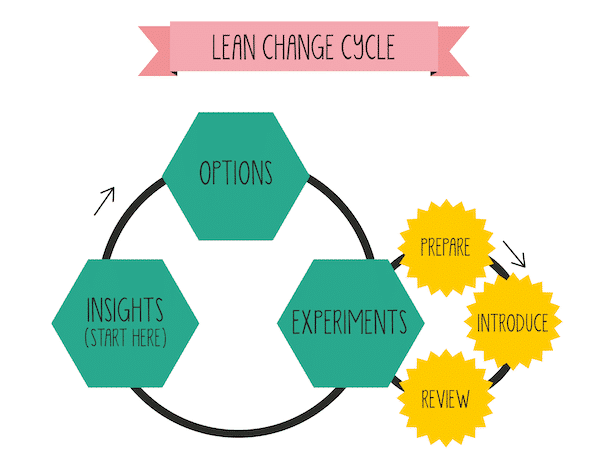
Source: https://leanchange.org
Lean Change Cycle:
Insights – What we know? What we need to know? What assumptions do we have?
Options – Given our new understanding from insights we ask: What could we do?
Experiments are the Options we’ll act on. Sometimes an Option might need multiple experiments, much like how agile software teams will use Epics and User Stories.
The Lean Change Cycle is abstract enough for people to figure out their own process around it. For example collecting insights: You do surveys, lean coffees, go to department meetings, go to the water cooler, go visit teams, talk to customers and gather all this data. It’s the same traditional plan-do-check-act. Just the language is different, with the emphasis being on short time horizons in the context of the bigger picture.
Source: https://leanchange.org
How would you start implementing these ideas?
1. Always start from yourself and where you’re at. Often change-people externalize things: How do I get other people to do these things? How do I influence them to do it? It just doesn’t work. You are not going to convince someone to do something they don’t want to do.
So you have to start from yourself: Where am I? What is my responsibility and the outcome? What are three things I can do this week to move it forward and how would I know that they worked?
2. Use very simple, clean and plain language. The more consistent and steady you are with that type of thinking other people will start to catch on. To use the Gandhi-cliche: Be the change you want to see.
Behavior is infectious: If you are starting with yourself, you start to energize and magnify people around you and eventually it is going to work, if it’s the right change.
What are the most common mistakes when driving change or implementing LCM?
1. Forgetting the context that you are in, or thinking of ‘applying agile to change management’ as being a way to do change at people more effectively.. I’ve used some of these ideas in larger organizations where they didn’t work because the culture just was not used to involve people in change. There’s an approach to change called the hole in the floor approach: That is, the people at the top drop the change through a hole in the floor and hope people figure it out. This is an idea taken from the book Becoming a Change Artist by Jerry Weinberg.
Changing culture in a big organization is like steering a big ship. You need to make subtle movements to make ship to shift course and it will take a long time. You can’t go from a culture that is used to running change from a place of control and planning, and push right over to hey, let’s just start experimenting. They’re just not compatible with each other. You have to remember the context you’re in.
2. Another common mistake from the part of management is forgetting team’s perspective of time. Even though management has been thinking about change for months, it is brand new to the team. The team is going to take at least three months to understand the purpose behind why they are wanted to do this. Whenever a CEO gets fired and someone new comes in they don’t make an impact right away. There’s already a bunch of inertia that has been put into place. Outcomes are a lagging indicator in the next quarter or the next 6 months or the next year. It’s the same with bringing in Scrum or anything like that which requires behavioral change.
3. Third common mistake is focusing on communication over enabling meaningful dialogue. Often a communication plan is nothing more than broadcasting, where communications people write a newsletter, they put it on SharePoint and push it out. They don’t have any other measurements. They don’t know who is clicking on the links, who is reading them, who is asking them questions and stuff like that. Don’t do newsletters, do lean coffee sessions. Get people in the room physically or virtually and let the people ask the questions. Use sticky notes and vote for the most important things. You are doing the same thing but just imploing a different tactic. You can do these little things without throwing everything out and saying “we’re doing this lean change management and don’t do planning anymore, now we do experiments”.
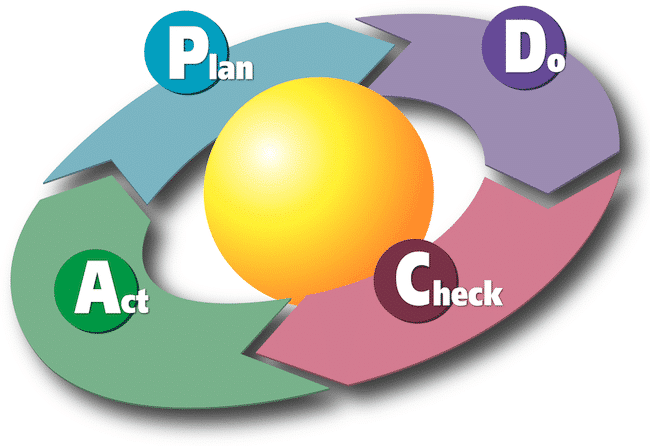
Diagram by Karn G. Bulsuk (http://www.bulsuk.com)
Plan-do-check-act is almost 70 years old, but is it still the basis on almost all change – methodologies?
Conceptually LCM and PDCA are the same, but when people see plan-do-check-act they go away for three months to create a perfect plan. Then execute the plan. Then do the check at the very end of the project. The word plan has baggage.If you go to “insights – options – experiments” it doesn’t tell you specifically to plan. It doesn’t tell you when to start or how to start. You need to understand your context and you need to accept what it is that you don’t know and what you need to know and then you come up with some options. That might take a day or a month. It’s extreme non-descriptive, which some people don’t like. Conceptually they are the same, LCM is simply more loose.
Key points regarding Topaasia® – Lean Change Management serious game:
One of the reasons I like the Topaasia-format is because we think of change as being kind of like an arc: We start the change, we go through the transition part and get to the end of it. This implies that we’ve got to have a big plan about all the stuff that we want to do and we need to have all the tactics in place. Where the game fits in to it is throughout the entire change there are happening all these little events and interventions. That’s where the changes really happen.
The game fits into these little interventions because the powerful questions get change-people to think about themselves first. They’re blaming resistance for the change not going forward and it’s usually externalized. The card they pick up in game can make people think “You know what? Maybe this is the problem” and then they can intervene. Then it’s going to be a little bit better or worse. But then they can do it again and they’re going to do a different experiment. Eventually the road straightens down a little bit.
These interventions are an exercise for clarity.
In fact, the story I told earlier about a group of managers that didn’t feel they had a compelling vision, and were therefore stuck, I used this game. They gravitated towards the ‘organizational perspective’ and ‘people perspective’ cards and after the discussion, they created a canvas and realized they were more aligned than they originally thought.
Every company is doing digital and agile transformation now because that’s just the way things are today. I would say the majority don’t really understand why. That’s just the new thing that everybody has to do. The more they take time to do these interventions -powerful conversations- the more clear they are which helps them to move towards the future. That work cannot be done upfront.

People many times recognize importance of powerful conversations intellectually (like retrospectives in IT-world) but still don’t take time for them.
Urgent things always take priority over the important things. That should be true to a certain extent. I used to be a developer and building stuff and getting it out the door will always be more important than improving. If we are spending all of our time improving then we’re not shipping any product. And some people think that if we spend all of our time delivering and not improving we’re out of business. It’s about finding the balance. I would always put more emphasis on delivery, but at the same time taking enough time to have small improvements. In one place I used to work we used to do trade shows every year, which basically meant “working until a demo is ready for a trade show”. That was a right thing for that company at that time, but somehow agile has made that a bad thing. Agile thinks about sustainable pace, but I loved the pressure of having to get something done by the trade show. It’s a huge challenge to solve. Don’t improve on those times.
If you have a three month crunch time to get stuff done, don’t improve anything.
Try to understand the context and what rituals you have in your company and when you have “natural” downtimes. That’s when you take the time to improve. If you have a three month crunch time to get stuff done, don’t improve anything. Get that delivery done and when there’s downtime, put efforts to improve things. Find the balance for what’s right vs. agile, that says “you shall improve every two weeks”. It’s nice if you can, but sometimes you can’t, so find the time when you can do it. Be clear in your thinking and change-endeavours.
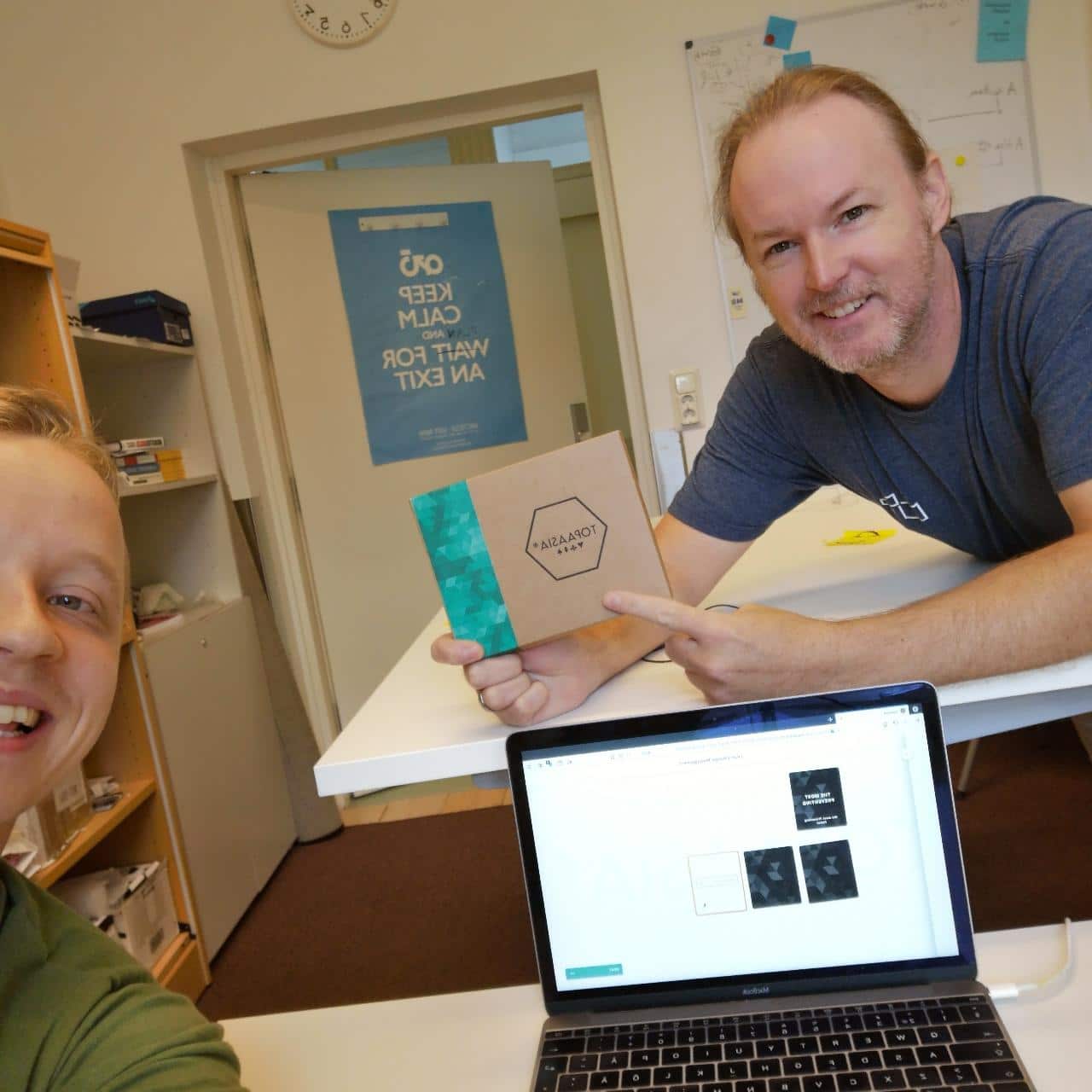
Jason and our Jussi celebrating new Topaasia Lean Change Management game at Helsinki office
Thanks Jason!
More on Jason and Lean Change Management:
http://www.agilecoach.ca
https://leanchange.org/author/jasonlittle/
Topaasia® – Lean Change Management and other Topaasia® – games can be ordered
from webshop
Topaasia – Lean Change Management is also as content in digital Topaasia-service.
Check it out and try for free.

